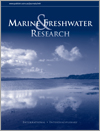Marine and Freshwater Research
Volume 75
Number 15 2024
This paper is the foreword to a collection on monitoring and research outcomes related to water management in the northern Murray–Darling Basin (MDB), Australia. It provides background on the northern MDB, along with a summary of papers presented in the collection.
This article belongs to the collection Environmental flows in northern Murray–Darling Basin: what we know about the science and management after a decade of practice.
We rescued and temporarily housed multiple cold-water fauna (mountain-top associated fishes and crayfish) in reacting to extreme drought. In captivity, predation and aggression both within and among species reduced survivorship. Further experimentation, adaptive management and infrastructure development is required to prepare for future rescues of cold-water fauna, based on likely climate-change scenarios.
This article belongs to the collection Environmental flows in northern Murray–Darling Basin: what we know about the science and management after a decade of practice.
We tracked golden perch in the highly modified Gwydir River to understand their response to different flows and the effect of barriers. Normally considered highly mobile, we found our golden perch to be highly constrained and largely sedentary, with little apparent connection to the wider population. The recovery and restoration of golden perch in the Murray–Darling Basin will require societal change.
This article belongs to the collection Environmental flows in northern Murray–Darling Basin: what we know about the science and management after a decade of practice.
Understanding fire and inundation impacts on wetland vegetation communities is crucial for effective post-fire wetland management. Here, we measured fire and inundation impacts on water-couch marshland in the Gwydir Wetlands and showed that fire was a major but short-term contributor to wetland vegetation change, whereas drought had longer-term impacts, and inundation regimes had the greatest impacts.
This article belongs to the collection Environmental flows in northern Murray–Darling Basin: what we know about the science and management after a decade of practice.
This investigation showed degraded wetland biodiversity near urbanising Hangzhou, with habitat loss to development, water pollution and invasive species. Strategic planning integrating ecological restoration and sustainable development is urgently needed to conserve these ecosystems critical for wildlife and human communities.
This article belongs to the collection Ecological monitoring and assessment of freshwater ecosystems: new trends and future challenges.
Successful fish stocking relies upon releasing cohorts directly into habitat containing suitable supporting resources. We compared residency and movement patterns of juvenile yellowfin bream stocked on artificial reefs and less complex natural habitat. Fish stocked on artificial reefs showed greater fidelity to their release site and were detected for longer periods. Future stocking of bream or other sparids should consider releasing fish onto artificial reefs, with benefits these structures provide likely to be greater for estuaries lacking naturally complex habitats.
This study assessed the ecological status of Pampas wetlands under various land uses by examining environmental factors and annelid assemblages. Four water systems were surveyed, showing correlations with environmental conditions. Specific annelid species were linked to factors such as nitrate and phosphorus concentrations. The findings underscore the importance of annelid assemblages in wetland monitoring and the need for sustainable watershed management.
This study reports on the contribution of three phytoplankton size classes to the total chlorophyll-a (Chl-a) concentration at three coastal stations in the Arabian Gulf. It included data on the seasonal cycle for total chlorophyll a, as well as for the three size classes, and indicated physicochemical parameters potentially driving these cycles. It was found that micro- and nanophytoplankton Chl-a are correlated to a similar set of physicochemical parameters, whereas picophytoplankton Chl-a has a distinctly different correlation model.
Microplastics (MPs) have emerged as a significant global issue. The current study was conducted to evaluate toxicological consequences of polystyrene MPs (PS-MPs) that alter growth, carcass, nutrient digestibility, haematology and histopathology of Cirrhinus mrigala fish. After 90 days of trial, findings showed a negative corelation between MPs concentration and all parameters. (Image credit: Syed Makhdoom Hussain.)
Studying beach environments by using boat-based methods has been difficult. Drone surveys were used to assess abundance patterns of large marine animals in south-eastern Queensland, Australia. Significant differences in the composition of animal groups were found throughout the year and among locations, with large marine animal sightings in >80% of flights conducted off North Stradbroke Island. This supports the use of drones to provide scientific data for hard-to-study marine species and inform management of coastal ecosystems.
The number of National Wetland Parks (NWPs) distributed across China has grown from zero to more than 900 over the past two decades. Is this unlimited growth always beneficial? After analysing the distribution and dynamic trends of China’s NWPs, we examined the resource-orientated and legal drivers that prompted the growth and its far-reaching ecological, economic, social outcomes and impacts.
The Ramsar Convention on Wetlands has addressed wetland–agriculture interactions, but without linking policy responses to agricultural drivers of change. An analysis of Convention documents led to four conclusions to close the loop. These covered deepening our understanding of how agriculture affects wetlands; exploring appropriate opportunities within agriculture to reduce impacts on wetlands; enhancing our ability to work with indirect drivers such as the demands for food; and ensuring that Convention documents were specific about the drivers of change and possible responses.






